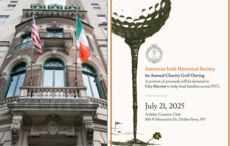As I write this, the sound from a lone bagpiper comes through my window. Not as unusual an occurrence as you might think. Irish America’s office is up the street from a church, the St. Francis Friary, the cornerstone of which was put in place in 1844, and where the friars still feed the hungry (what better way to remember your ancestors this St. Patrick’s Day than to give to a food program?) I don’t know if the piper is heralding a wedding or lamenting a death. Is he/she part of the annual celebration of mass for the laborers’ union, or just someone practicing for St. Patrick’s Day? There’s a fire station across the street from the church, perhaps it’s one of the FDNY Emerald Pipe Band making his pipes ready for the parade?
I’m too busy to leave my office to find the source of the music, but as I strain to identify the tune, I’m given to musing how the Irish have put their stamp on American culture. How at wakes and weddings, no matter the ethnicity, an Irish piper is often on the scene, and always, it seems, we are leading the parade, any parade.
It’s extraordinary really, given the poor start we had in America, how we have come to be such an integral part of it. The diverse group of leaders in our Hall of Fame, and Irish American of the Year John Lahey, are proof positive of our accomplishments.
Indeed, there are days when it seems that we have a hand in, or a connection to, every aspect of American life – even in outer space where astronauts Mark Kelly and Cady Coleman are keeping the Irish-American flag flying.
Cady, an avid flautist, has with her in space a tin whistle given to her by Irish musician Paddy Moloney. (Check out our new “What Are You Like?” column, which we kick off in this issue with Paddy himself taking questions.) Paddy and Cady are working out the logistics of doing a duet together. He from earth, she from space!
Perhaps Cady is related to the Sligo fiddler Michael Coleman who emigrated in 1924 to America but whose recordings brought the music back home again, reinvigorating the traditional music scene in Ireland.
This back-and-forth between Ireland and America and the cross pollination of cultures is a major theme in this issue, and as always our motto is:“Cuimhnigi ar na daoine a dtainigh sibh uathu,” which translates as “Remember the people you came from.”
In choosing John Lahey as Irish American of the Year we are honoring someone who is an educator and a memory keeper. Through Quinnipiac University’s “Famine” collection he is ensuring that the suffering the Irish endured is not forgotten. Sean Reidy, the CEO of the Dunbrody Famine Ship, is doing his part too. The Dunbrody made many trips across the ocean, ferrying the Irish over to the New World during Famine times. A replica of the ship is now in dry dock in New Ross, County Wexford, and will open in May along with an interpretive center. It is here that we will house our Hall of Fame.
With the Famine in mind, let’s look at our cover painting, which I first interpreted as a Famine ship making its way across the ocean. I see the spirals as a symbol of hope and home. But if you look closely at the painting you will also see a butterfly, and the image at the bottom may not only represent a ship but also a cocoon. (In Irish folklore the butterfly is a symbol for a soul crossing over into the Otherworld.) This symbol of metamorphosis, the painter Odette Videau says, can be interpreted as “the courage, fearlessness, and resilience of the Irish spirit in confronting adversity and discovering a spiritual dimension.”
The painting, called Vol de Nuit (Night Flight) is based on the fable of the butterfly who cannot wait for the daylight and comes out at night. In the past the Irish couldn’t wait either. They had to take a leap of faith and cross that ocean, sometimes in the dead of winter, in order to survive. The best of us, including those in our Hall of Fame, have an inherited memory of that dark night of the soul and reach back to bring others into the light.
Painful as it is, Ireland is going through another metamorphosis, and once again the youth are taking flight to all corners of the world. We can only hope, as in the past, that something good will come of this painful leavetaking. And we can find some consolation in the fact that everywhere those young Irish go they will be carrying their culture and music with them. And that is a great gift to the world.




Comments